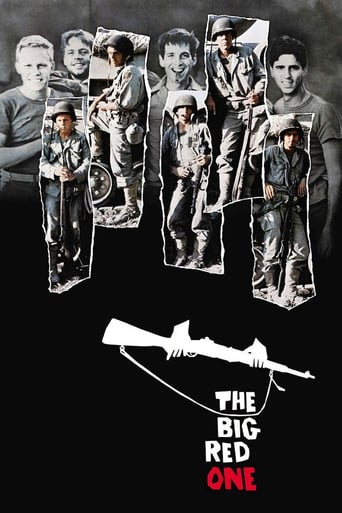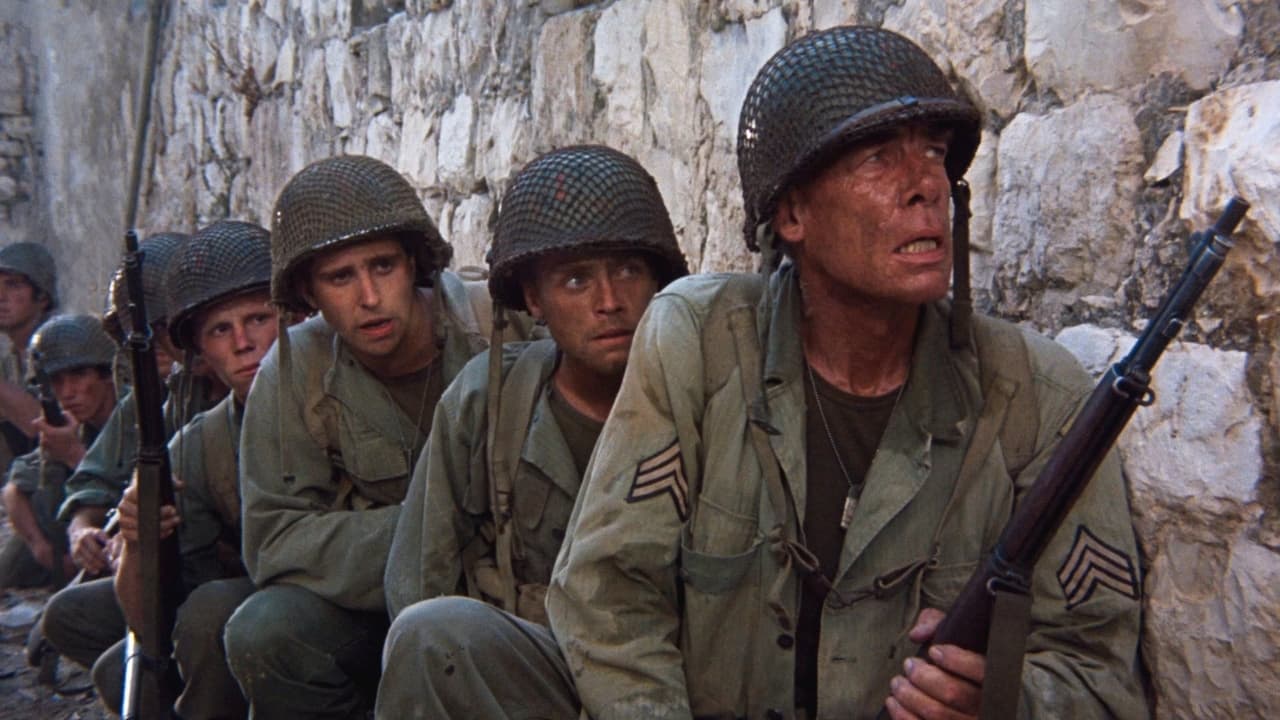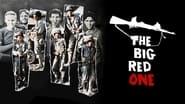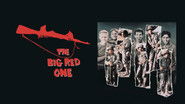SnoopyStyle
It's 1918 at the end of WWI. A private (Lee Marvin) kills a German soldier but he finds out that the war is already over. It's then WWII as the same soldier now as Sergeant of a squad in the 1st Infantry Division nicknamed The Big Red One. They land on the North African shore but Private Griff (Mark Hamill) is unable to kill. The Sergeant is injured and captured during Kasserine Pass. He escapes during a battle dressed as an Arab and rejoins his unit going to Sicily. Only four men remained from the original twelve. After Sicily, they are sent to Normandy on D-day.This is basically a series of small squad action instead of large epic set pieces. It's interesting to go small in a big budget movie. It doesn't have great memorable characters other than Lee Marvin as the nameless leader. He shouldn't be the lead character. He's more fitting as a supporting character. This movie is in desperate need of Hamill taking charge but he never does. The guys become nameless faceless cannon fodder although that's kind of the point.
Paul Magne Haakonsen
For a war movie from 1980, then "The Big Red One" was actually quite good. Sure it was no "Saving Private Ryan" or "Band of Brothers", but it did hold up its own quite nicely.The story is about a group of soldiers who make it through the various campaigns throughout World War II, spanding from Africa to Germany and everything in between.The movie did, however, come off as somewhat fractioned, as if the red thread throughout the movie had been cut in various places and then tied together, and the result was this movie. That being said, then the movie is still enjoyable. But it tends to jump from location to location in a manner such as the audience never really gets attached to what's going on, and once we start to get into it, then the year and location changes."The Big Red One" does have some good people to the cast list, and it is no secret that I bought this movie solely because I wanted to see Mark Hamill in a war movie. And it was actually quite a nice treat to see him in this movie. The movie is driven by some good characters, however, unlike "Band of Brothers" or "The Pacific", then the audience are never really let into the inner sphere of each of these characters, and as such something was lost to the movie, because the movie failed to build up a relationship between the characters and the audience as a whole.If you enjoy World War II movies, then "The Big Red One" is definitely well worth watching. And for those of the slightly older generation, then Lee Marvin does put on a good performance in this movie as well.
James Long
I was looking forward to seeing this film as I am a big fan of WWII movies but this film was a big letdown. It is hard to know where to start and whether I should waste any more time commenting on a film that has already wasted nearly 3 hours of my life.What we have here is what seems to be a buddy movie. A group of friends having a whale of a time on holiday in Europe during WWII. I know that sounds ridiculous but thats how the movie feels. The starkness and harsh reality of war is not what you see in this movie, war almost seems like fun. Of course not for the minor characters who keep ending up dead but for the principal characters it is all just a laugh.The dialogues is terrible and full of clichés. I know many war movies are riddled with clichés but its not just that. The dialogues is just absurd at times. And all the characters are just walking clichés, especially the European characters. The Italians are typically over the top. Children and old grandmothers are sweet and innocent. These are just a couple of examples.All the sub-plots in the film are completely ridiculous. Children for some reason seem to be attracted to Lee Marvin's character like he is the kiddy snatcher from chitty chitty bang bang bearing gifts of sweeties. Germans fall out of line by telling their commanding officers how much they hate Hitler until their predictable execution. The whole ridiculous birth scene inside a tank is done in very bad taste. Then you have a young Hitler youth who has killed some American G.I's and then has his trousers pulled down and spanked.The beach scene when the Americans arrive in North Africa is probably the most ridiculous scene I have ever seen in a war movie. They start off fighting the French Vichy soldiers and as soon as the Vichy commander is killed the french troops surrender and then run over to embrace the Americans.As you have seen I have mostly just tried to state things as they actually happen and not give my personal opinion. You don't need to give opinions to show how absurd this film is, just stating what happens illustrates enough.Also there seem to be many homosexual innuendos in the film. Nothing wrong with that but they are very bizarre. I could go on and on here, I could talk about the terrible acting, the stupid plot and the historical inaccuracies but I will save it.If you like to hear things go BANG ! and see a bit of blood and guts then this is the movie for you. If however you want a movie with just a little substance to it then please do yourself a favour and avoid this awful movie.I know my review might be a little incoherent in style but I just wanted to quickly get this off my chest before going to bed. This is the first time I have written a review and that is because I have never felt so strongly about a films shortcomings as much as I did for this film.I know the director Fuller served in WWII, but that doesn't prove anything. I respect his bravery in serving his country during WWII but as a director I have no respect for him. This is simply one of the worst films I have ever seen.
tieman64
"In cinema's presumption, in its pretension to being the real - which is the craziest of undertakings - no culture has ever had toward its signs such a naive, paranoid and terrorist vision." - BaudrillardThere are only five or six types of war films, the most common being "the Platoon movie". Traditional this sub-genre contains three basic elements: hero, group, and objective. The group is made up of a mixture of ethnic types, most commonly including an Italian, a Jew, a cynical complainer from Brooklyn, a sharpshooter from the mountains, a Midwesterner (nicknamed by his state, "Iowa" or "Dakota" for example), and a character who must be initiated in some way (a newcomer without battle experience) and/or who will provide a commentary or "explanation" on the action as it occurs (a newspaperman, a letter writer, an author, a professor). As the group moves forward, action unfolds in a series of contrasting episodes that alternate in uneven patterns: night and day, safety and danger, action and relaxation, dialogue and non-dialogue, comedy and tragedy, good weather and bad weather, combat and non-combat, and so on. Military iconography is used and explained, conflicts break out within the group (in which the objective, leadership and war itself is questioned), rituals from home are discussed and remembered and new combat rituals are enacted. As the group advances, they encounter the enemy and certain members die. A final climactic battle, often a last stand referred to as an "Alamo", takes place at a bridge or in a town, and reveals the film's overall purpose. The hero or narrator, who has usually had the objective forced on him, then has to make a series of difficult (and unpopular) decisions. He sometimes survives (although most of his men don't), and he sometimes dies. These films were common in the 40s and 50s, and rarely deviated from this formula. The genre remained silent for a number of years, thanks mostly to the Vietnam war, before two films reactivated it briefly in the 80s and 90s: Sam Fuller's "Big Red One" and Steven Spielberg's "Saving Private Ryan".Fuller's film, which eschews realism at times for a more metaphysical outlook, and which revokes corny moralising in favour for stoic silence, has been criticised by some for being "fake". Filmed on a minuscule budget (1/25th the budget of "Private Ryan") and without the benefits of modern technology, viewers dismiss it as a "dated movie". But with repeated viewings (and an extended cut released recently) the film reveals a maturity, an immediacy, a sort of no-nonsense authenticity, that most "platoon" films lack. Indeed, of all WW2 platoon movies, from "Bataan" to "Guadalcanal Diary" to "Objective Burma" to "Saving Private Ryan", the trio of "The Big Red One", "Beach Red" and "The Thin Red Line" are arguably the best, not because of their "realism", but because of their metaphysical trimmings. But when people complain that old war films are "not realistic", what do they really mean? When "Bataan" was released (the first film to pull together all the elements that came to define the genre) it was praised for its "gritty realism". Shot entirely on studio sets, viewers and critics were blown away by its extreme violence, its authenticity and the bloody "Alamo" finale in which everyone dies. A violent beheading (which largely occurs off-screen) was deemed particularly shocking, despite the fact that no blood is shown. As time passed and censorship restrictions were loosened, genres of violence (horror, war, gangsters, and westerns) all increased in bloodiness. Sam Peckinpahs "Cross of Iron" and "Platoon" were praised in their day for their gore and realism, but today both seem hopelessly stupid. Likewise "Private Ryan" and "Black Hawk Down", two films praised for "taking it to the next level", today look indistinguishable from next generation hyperreal computer game shooters. In reality it is only technology that progresses, cinema's "understanding of war" regressing into the infantile comfort of movie narratives over 90 years old.And yet with each wave of technological innovations, the latest war films pretend to bring us "closer to the truth of war". When "Private Ryan" was released advertisements proudly proclaimed "Now You Know!", the implication being that after witnessing the film, we now know what combat is like. Hyperrealism has somehow become conflated with truth, when in fact the two are often in complete opposition.The shaky, desaturated looks of "Ryan", "Schindler", "Black Hawk" and "Hurt Locker" are designed to simulate reality, when in fact they mimic archived, documentary or news footage. The intention is thus not to bring us closer to reality, but closer to a mediated hyperreality, an image of an image of an image, regressing further into what Baudrillard calls the simulacra, further and further from any ground zero reality.Coupled with this, these films offer a curious lack of any real insight into the psychology of the soldiers or the nature or politics of warfare. Beyond spectacle, we get offers of heroism and redemption, but little else. It's as though an obsession with rendering the aesthetics of war "real", has pushed past realism into video game simulation and rendered all context and truth void. All that matters is the look and sound of the thing. Surfaces are all you need to know.This, of course, is Baudrillard's description of the 21st century American desert-city. Surface is no longer about the realisation of a thing's essence, about history and truth, but assumes almost the exact opposite meaning. An overemphasis of depth-less surfaces leads to object-hood, rather than art.8/10 - Whilst most war films ("Ryan", "Schindler" etc) exploit the context of war to tell a story of rescue, survival and redemption, the restoration of family and the recuperation of a nation and its history, Fuller has less propagandistic aims. Like his earlier war films, this is pulp journalism, prose before image, his blunt poetry capturing the tone of a Jones or Hemingway.



 AD
AD






